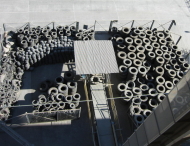Lafarge expertise in waste solution
Lafarge’s expertise in safe waste solutions
Since it first began using waste products as an alternative fuel in the 1970s, Lafarge has developed significant expertise in this field.
|
The use of waste products as a resource requires careful planning and execution. Lafarge has established:
In this way - and with the active contribution of Lafarge R&D teams - Lafarge is able to reinforce the use of alternative fuels and materials while optimizing its own industrial processes.
Lafarge Cement sees the use of alternatives and the pursuit of industrial ecology as distinct but complementary aspects of its core business. To leverage its expertise, Lafarge has developed a dynamic strategy and a dedicated organization, both globally and within its operational units.
Lafarge also enters into partnerships with local waste processing specialists. Lafarge has acquired share capital in Systech, a major waste management company in North America. |

La Calera Cement Plant's tire stocks used as alternative fuels in the kiln Cementitious mineralsUsed as "cement additives" in the last phase of cement production, cementitious minerals make possible a range of cements with varied properties. They can be:
Using cementitious additives reduces CO2 emissions because:
Silica fumeThis by-product of the silicon industry results when quartz is heated to high temperatures. Silica fume, consisting of dust particles that measure only 0.2 micrometers, is collected by electro-filters for use as a cement admixture.
SlagA mixture of lime, alumina and silica produced when iron is smelted with coke in blast furnaces. Slag accumulates on top of the molten cast iron. If cooled quickly, its hydraulic properties are close to those of clinker. Slag takes longer to hydrate, but is more stable in corrosive conditions. It is thus a suitable additive for cement and concrete to reduce CO2 emissions.
Fly ashFly ash is hydrophilic and can be used as a cementitious additive. Typically collected from chimney filters in coal-fired power plants, the ash is composed of vitreous silica, alumina, iron oxide and lime. Fly ash can be used as a partial substitute for clinker, thus helping to reduce CO2 emissions.
Industrial wasteIndustrial waste is the residue from industrial production, processing or use. Waste products from one industrial process can serve as alternative fuels and raw materials for another.
Co-incineration enables enterprises to conserve fossil fuels and raw materials while serving the community by processing waste in an economical way that reduces CO2 emissions.
|





